Although the German Zeppelins get the majority of attention, they were far from the only naval airships used during WWI. The British, after being burned by Mayfly, switched their efforts to non-rigid airships, which are held in shape by gas pressure. The first was bought before WWI, but most effort was focused on heavier-than-air craft. When war broke out, there was an immediate need for longer-duration surveillance than airplanes could achieve, and the first SS class blimp1 was created by hanging the fuselage of a BE.2 airplane beneath the envelope from an earlier airship. 59 more followed, 14 of which went to France and Italy, each with a crew of two and the capability to carry 160 lb of bombs. They proved very effective as escorts for coastal convoys, able to stay in the air for up to 12 hours. None were able to successfully sink a U-boat, but they were invaluable for spotting them closing in and vectoring in the escort. U-boats were obviously reluctant to surface when airships were nearby, and from mid-1915 onward, only two ships were sunk in convoys protected by airship.
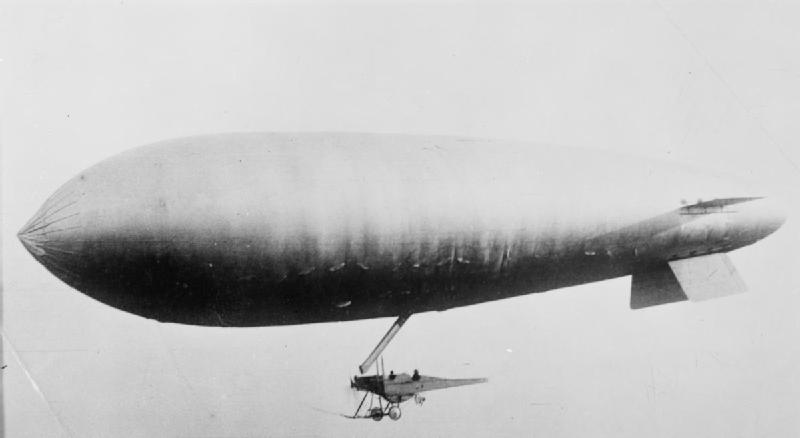
An SS class blimp
But the SS class, which eventually totaled 158 airships in a number of variants, was an extremely simple and short-range design, and work soon began on several other types with greater payload and more range and endurance.2 The first was the C or Coastal class, which had a unique 3-lobed balloon, a crew of 5, and the ability to sustain 45 kts for 11 hours. While it did have the ability to carry several bombs, it was still intended primarily as a scout, which required a precise knowledge of its position for communication with surface ships. This was accomplished by a network of shore direction-finding stations, who would triangulate on the callsign of the airship and transmit its position back to it. The increased range also took them within reach of German fighters from time to time, and machine guns were installed, including a position on top of the gasbag, accessed through a tunnel in the bag.3 An improved version, known as the C star, was developed to replace the C class as they wore out. To give them a serious anti-submarine capability, plans were made to fit them with hydrophones that could be lowered from a hover4 and circling torpedoes set to run at periscope depth, but this was overly ambitious, and nothing came of it.
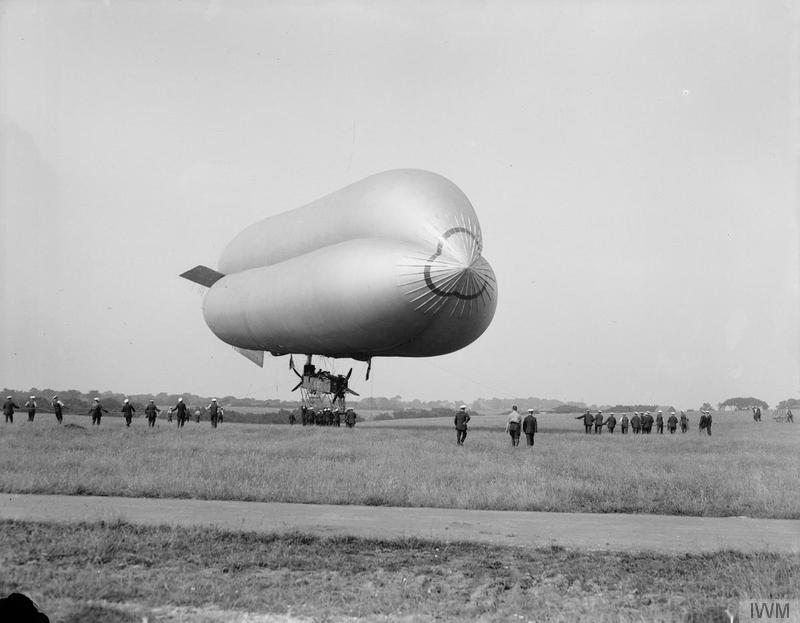
A C class airship
By 1917, even more range and endurance was desired, and the British developed the North Sea or NS class airship, with a crew of 10, and endurance for 24 hours at 50 kts or more. Despite some initial teething problems, these gave good service in the last two years of the war, patrolling further out to sea and setting new records for non-rigid airships. Tests were carried out to see if towing an airship low on fuel from a destroyer was feasible (it was) and if they could exchange passengers with a ship (also possible).
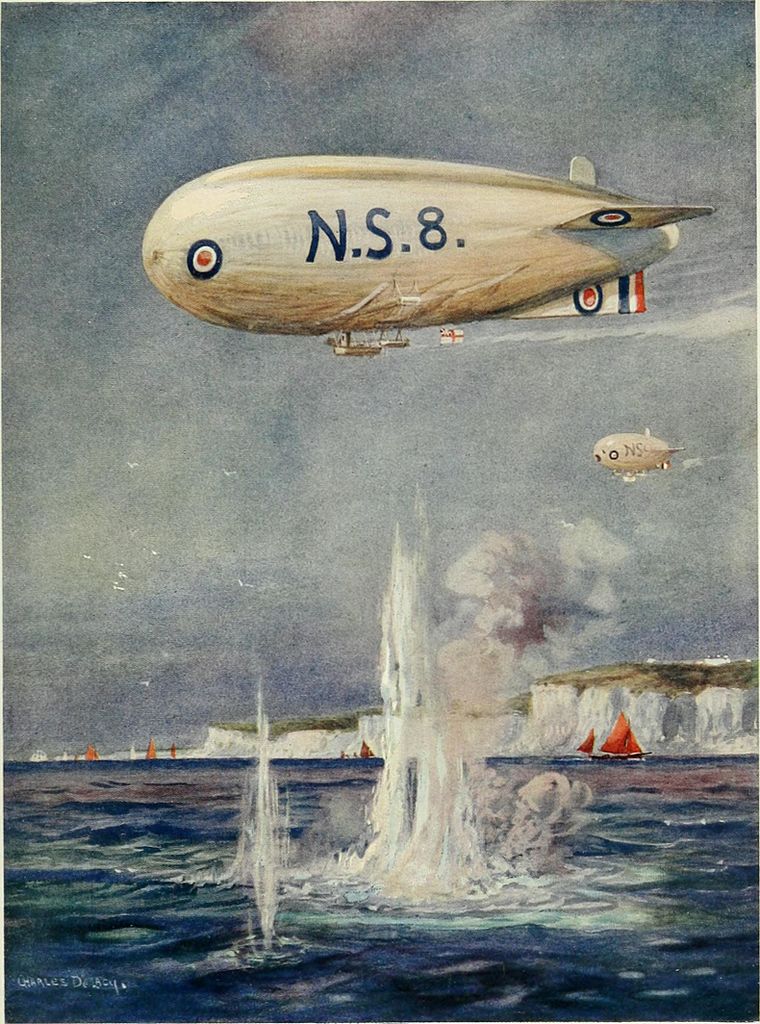
NS class blimps attacking a submarine
But while non-rigid airships were cheap and easy to build, they were also slow and small compared to rigids, and even the Mayfly disaster wasn't enough to deter the British from continuing work. Their second rigid airship project had begun in 1913, with Airship R9, although the need to rebuild the design organization and various technical problems delayed construction. Churchill, long an airship skeptic and booster of heavier-than-air flight, cancelled it in early 1915, but work resumed a month later after his ouster from the Admiralty. More issues, including delays in the delivery of Irish flax, meant that it wasn't ready to fly until late 1916, the first British rigid airship to do so. As a prototype, it was never used operationally, but did give useful experience with handling and mooring of a Zeppelin, including pioneering the mooring mast, much cheaper than the massive sheds that had been the only option for rigid airship storage up until that point.5
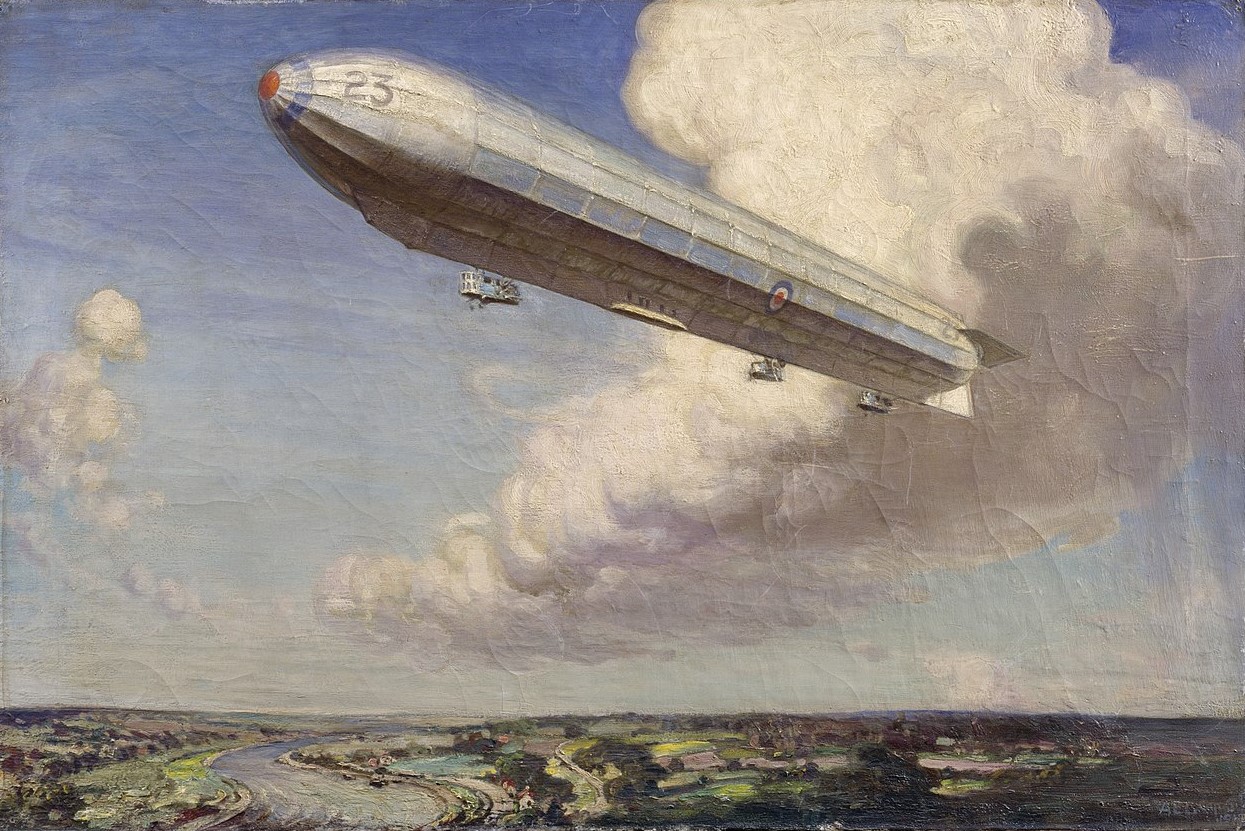
Airship R23
Even before R9 was completed, the Admiralty ordered four more rigid airships to a modified version of the design, known as the R23 class. These entered service in late 1917, and joined the non-rigids, particularly the NS class, in patrol missions. As longer-ranged airships operated closer and closer to German territory, they came under increasing threat from German fighters. To counter this, experiments were done with carrying a Sopwith Camel along. It would be dropped, the pilot lighting the engine in a dive, shooting down the attacker, and then hooking back onto the airship. Tests were successfully carried out by R23, but the war ended before the idea was used operationally. More rigids were ordered, four of an improved "R23X" design and two R31 type which used wooden frames based on the German Schuttte-Lanz design. Only two of the R23Xs were completed in mid-1918, although one of them, R29, took part in the only successful attack on a submarine by a rigid airship. That September, her crew spotted an oil slick and directed surface forces that sunk UB-115. R31, completed only days before the Armistice, was, with her sister R32, the largest mobile wooden structure ever built. However, the glue holding the wood together was easily damaged by moisture, and she was destroyed after only a few flights. R32 did better as a research platform after the war before also being broken up.
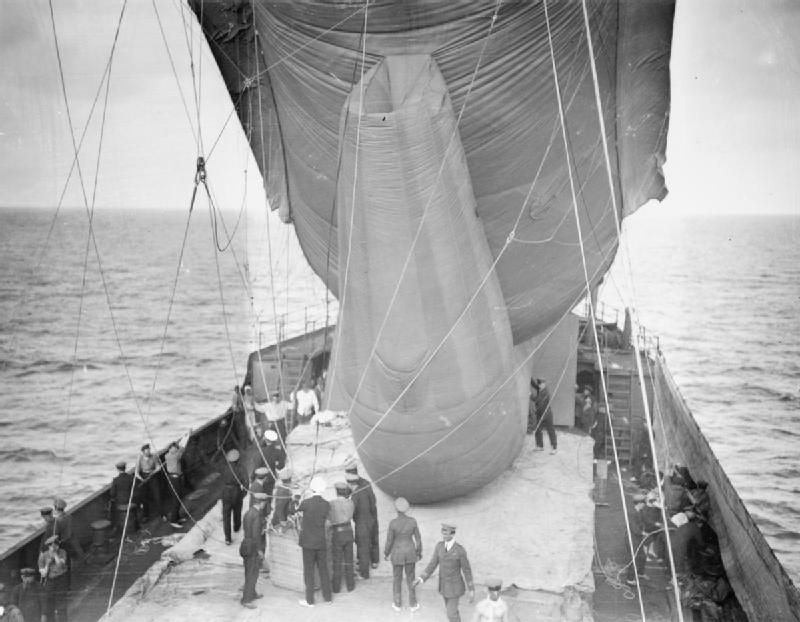
A kite balloon is inflated on the deck of Manica off Gallipoli
One other facet of the British lighter-than-air program that deserves mention is the use of the kite balloon, tethered balloons used for observation. The British started the war with spherical balloons, but these tended to be unstable in any but the lightest wind, or from a moving ship. A section was sent to the Belgian coast to spot for naval gunfire, but its members soon saw that other powers had solved this problem by streamlining the balloon, producing something that looked essentially like a blimp. These became known as kite balloons, and the RN first used them to support the Gallipoli landings. The tramp steamer Manica was converted to support balloon operations and rushed to the theater, where her balloons proved extremely valuable at spotting naval gunfire. While aircraft were also used in this role, the ability of the balloon to communicate via telephone, instead of the primitive radio of the day, made them far superior. Four more balloon tenders were converted, and one was used off the Belgian coast, with the balloons often sent aloft, then passed to other ships that could approach closer to shore in the face of German defenses.
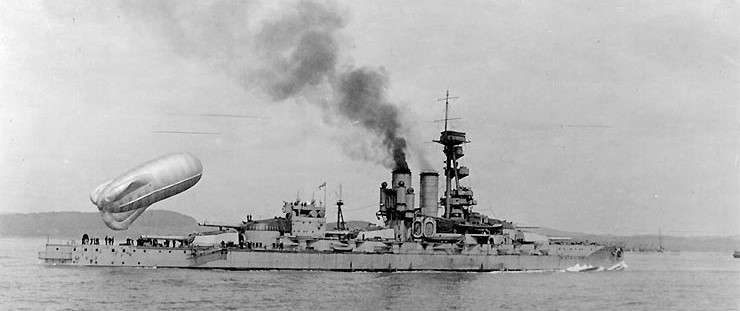
A kite balloon flying from HMS Erin
Trials were also carried out to investigate the use of kite balloons in support of the Grand Fleet. Many thought they could operate in conditions that neither Zeppelins nor seaplanes could, and at 3,000', the observer could see up to 60 miles. Making this potential reality was complicated by the fact that none of the balloon tenders were capable of more than 13 kts, and no fast merchant ships were available to take over the job. Still, trials were carried out by seaplane carrier Engadine, which successfully tested towing at 22 kts. Eventually, all but one of the depot ships were returned to merchant service, but Admiral Beatty, by now in command of the Grand Fleet, finally prevailed on the Admiralty to fit balloon winches to 20 of his ships, ranging from battleships to destroyers. The balloons were inflated ashore, then the cables passed to the ships before they left harbor. To avoid the dangers inherent in having a large amount of hydrogen on the deck of a warship, the balloons were only brought down to embark or disembark the observer, and no problems were found with simply towing them unmanned during transit, although at least two were lost to lightning while under tow. Besides extending the eyes of the scouts, the Grand Fleet also experimented with gunfire direction from its balloons, although they never saw action before the High Seas Fleet came to be interned.
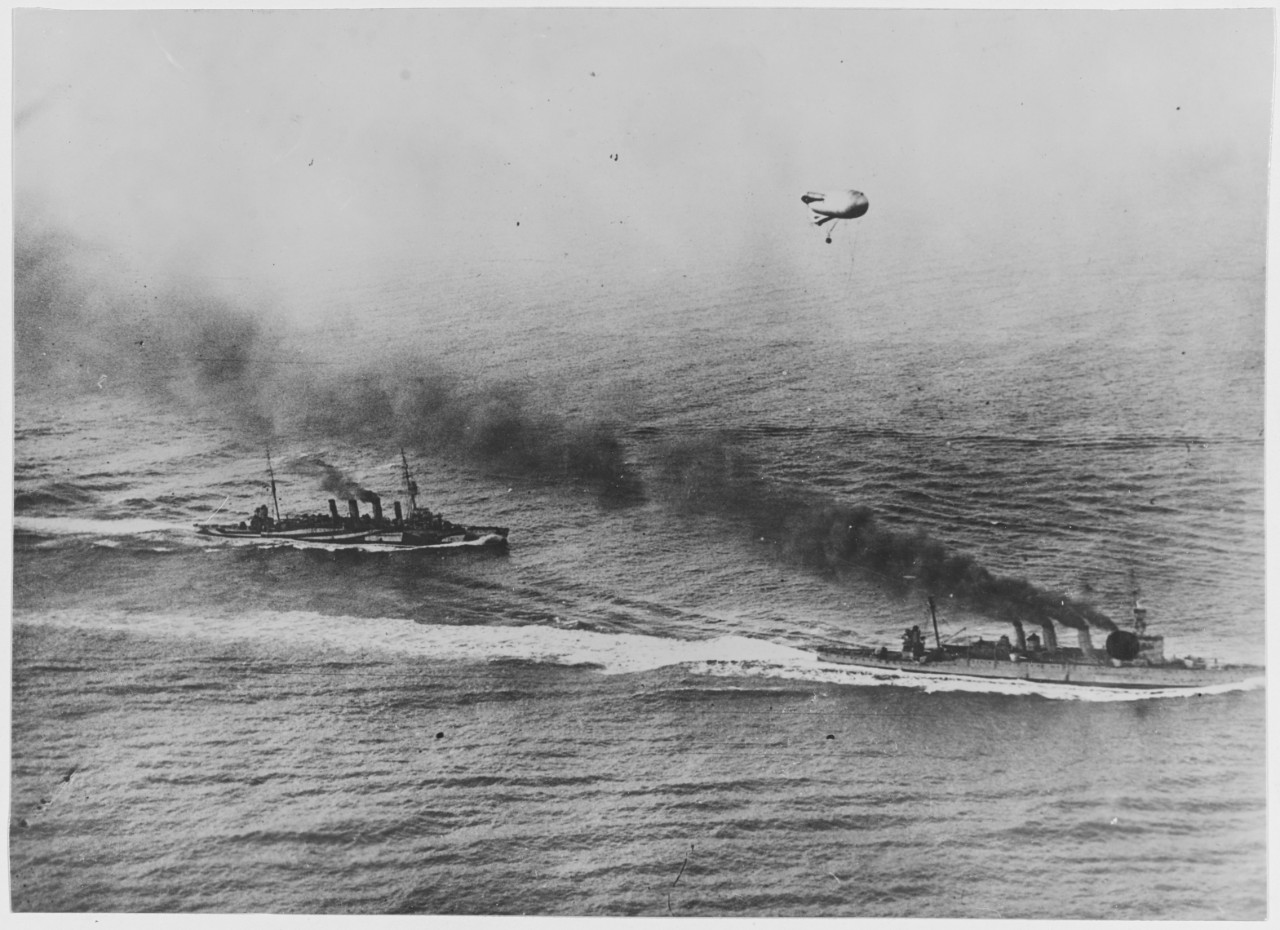
A kite balloon is towed by British ships
Kite balloons were also used extensively in the anti-submarine campaign, giving the forces protecting a convoy an aerial vantage point from which submarines could be seen, in one case up to 28 miles away. While critics contended that the balloon would give away the convoy's position (a similar concern was raised with regards to balloons for the Grand Fleet) on the whole, the kite balloons were a major success for ASW work. 152 escorts of various types were fitted with balloon winches, and while the exact numbers aren't clear, only a handful of ships were sunk in convoys that had them.
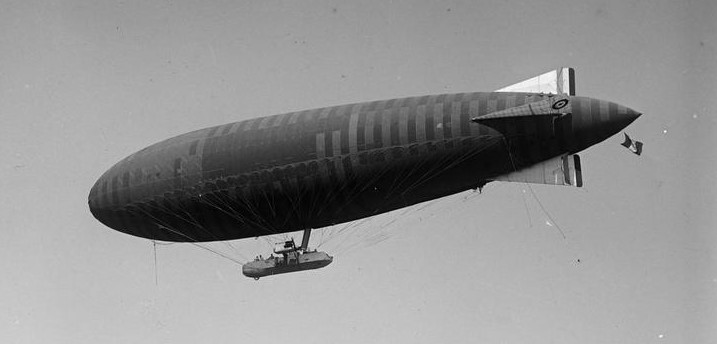
A French naval airship in the Mediterranean
Other nations also had lighter-than-air programs for their navies. The French had a small but reasonably successful airship program, with 37 in operation by the end of the war. Some were equipped with guns of up to 75mm for use against U-boats, and one was responsible for the only kill of a submarine by an unassisted airship during the war. Unfortunately, it was a British submarine, pointing to the difficulty of identifying such vessels from the air. The Italians had a similarly-sized force, but few details are available. Both navies also operated kite balloons, many borrowed from the British. All Russian airships were operated by the Army, and it doesn't look as if any were used in support of naval operations.
The last major power to operate a naval airship force was ultimately the one that would stick with it the longest. Next time, we'll take a look at the USN's first steps into the lighter-than-air arena.
1 Interestingly, the word "blimp" appears to have originated from someone flicking the gasbag of an SS, and then mimicking the sound it made, which came out as "blimp". ⇑
2 To increase endurance, trials were carried out to refuel airships from surface ships, particularly HMS Furious. They were successful, but the war ended before more could be done. ⇑
3 Many airships had at least some access to the top of the gasbag, as it was necessary for celestial navigation. ⇑
4 Precursors of the dunking sonars used on helicopters today. ⇑
5 Storage was never a problem for non-rigid airships, which can be deflated and rolled up. ⇑

Comments
Never change, France.
Looking at pictures of kite balloon baskets, it looks like the men had a small field telephone, and surprisingly little observation gear other than small binoculars?
I wonder what the casualty rate of land and sea-based balloon men was.
@echo
In fairness, what else would they bring?
Pre radar, I can't imagine what sort of other sensors you could put up there besides an eyeball and whatever sort of magnification they could get without too much wobble/blur.
There were stabilized optics at the time, but they were big, expensive, and probably not that effective if placed in the moving basket of a balloon.
@bean
Clearly they needed electric stabilization gyros!
The linear movement should be much less of a concern than the rotational movements, right?
(I actually think the tech was there, just impractical...)
What lead to the end of the kite balloon? I'd have thought that it would have still been useful for ASW in the second world war, and then as a means of pushing out your radar horizon. Even once helicopters come in to play I'd have expected them to have some advantages, though operating both could be tricky, and helicopters would be more useful.
@redRover
Arthur Pollen (of Argo Clock fame) made his money during this era by providing stabilized rangefinders to the RN, so yes, the technology existed. The problem is that these weren't small, and every pound you have to lift makes the balloon bigger and harder to deal with. Also, you're not operating from a relatively stable ship, but from a very unsteady balloon.
@Alexander
I cover this some in Part 4 (which is going to be a while coming, because I got distracted talking about other things) but the short version is that balloons are difficult to handle, and the idea was pretty much dead by the time that radar might have made a difference. As for ASW, it's something that works well close to shore, but much less well when you're trying to cover the entire Atlantic, as they did in WWII.
@echo
I don't know about the observers, but the casualty rate of fighter pilots attacking land-based artillery spotting balloons was spectacular even by 1916-18 standards. They were often ringed with flak and covered by combat air patrols. Some (crazy) pilots made "balloon busting" a speciality and there were balloon aces.
I have heard (not sure how true this is) that WW1 balloon crews were issued with parachutes, while aircraft crews weren't because it was thought that they would encourage cowardice...
I'd guess it had less to do with cowardice and more to do with the fact that balloons had a lot more weight-carrying capacity than fixed-wing aircraft at the time.